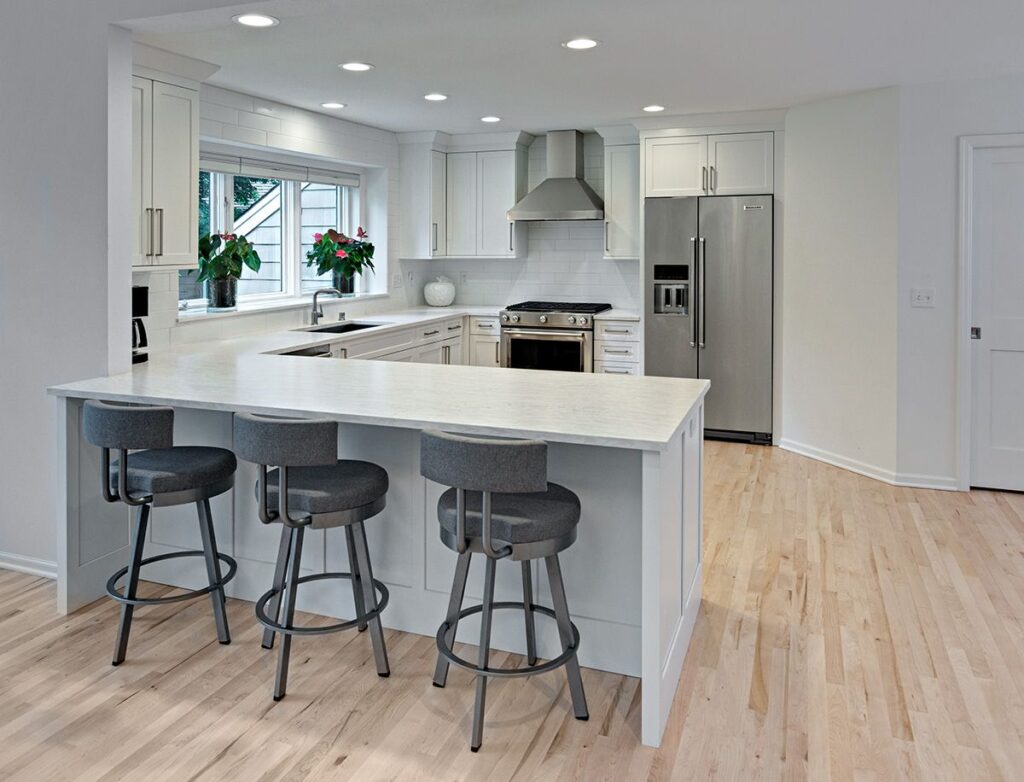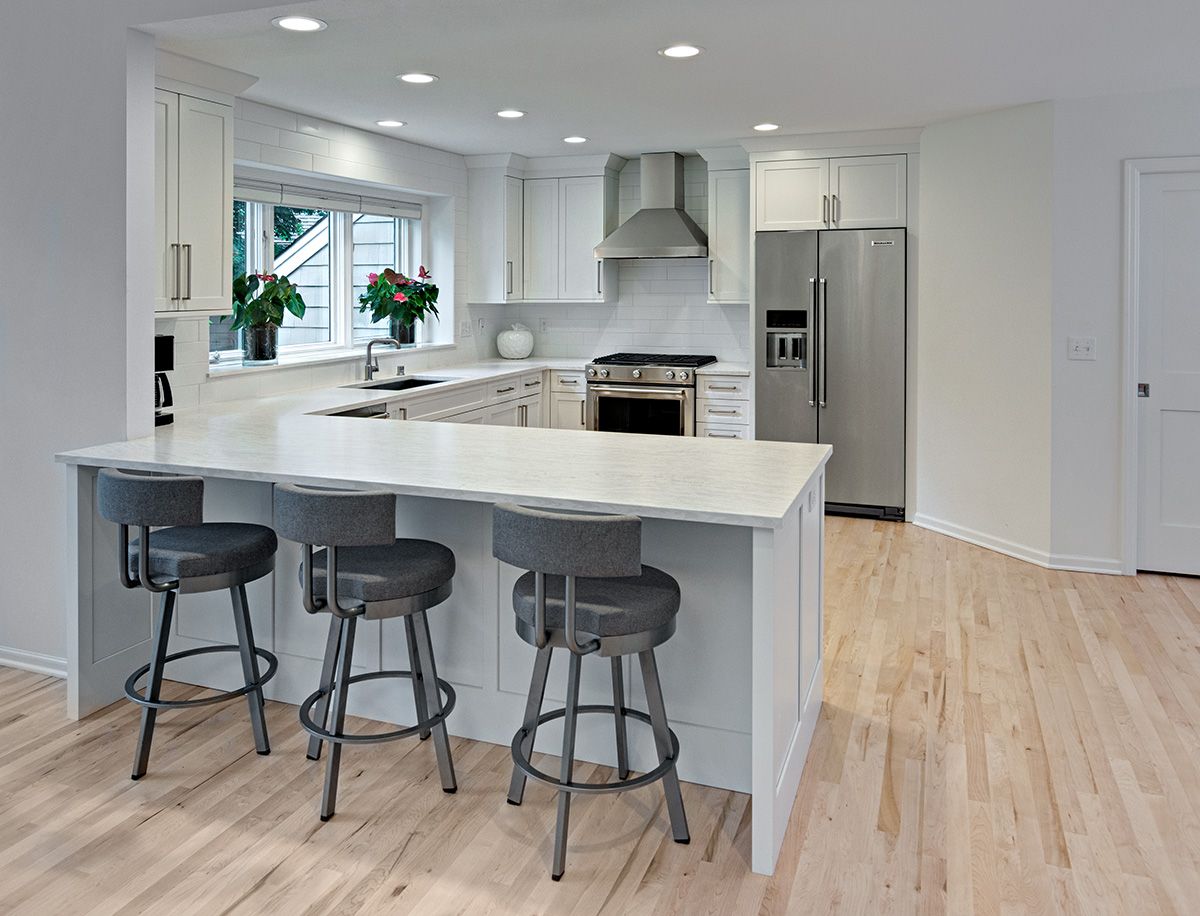
Should a Peninsula in Kitchen Have a Breakfast Bar? Weighing the Pros and Cons
The question of whether a peninsula in kitchen designs should incorporate a breakfast bar is a common one for homeowners undertaking renovations or new builds. A kitchen peninsula offers a versatile extension of countertop space, but adding a breakfast bar component brings another layer of functionality and design considerations. This article delves into the advantages and disadvantages of including a breakfast bar in your kitchen peninsula, helping you make an informed decision for your space.
What is a Kitchen Peninsula?
Before diving into the specifics of adding a breakfast bar, it’s important to understand what a kitchen peninsula is. A peninsula in kitchen design is essentially a countertop extension that is connected to the main kitchen area on one side, creating a ‘P’ or ‘L’ shape. Unlike an island, which stands alone, a peninsula is always attached to a wall or cabinet run. This makes it an excellent option for smaller kitchens where a full island might not be feasible. Peninsulas can serve multiple purposes, including food preparation, serving, and, of course, functioning as a breakfast bar.
The Allure of the Breakfast Bar
The inclusion of a breakfast bar on a peninsula in kitchen layouts is driven by several appealing factors. It offers a casual dining space, perfect for quick meals, snacks, or morning coffee. It also serves as a social hub, allowing family members or guests to interact with the cook while they’re preparing food. Furthermore, a breakfast bar can provide additional seating, which is especially useful in homes with limited dining space. Adding a breakfast bar to your peninsula in kitchen design can increase functionality and visual appeal.
Advantages of a Breakfast Bar on a Kitchen Peninsula
- Increased Functionality: A breakfast bar transforms a simple countertop into a multi-functional zone. It’s a place for eating, working, or socializing, all within the heart of the home.
- Space Saving: In smaller kitchens, a breakfast bar can eliminate the need for a separate dining table, freeing up valuable floor space.
- Social Interaction: The open design of a breakfast bar encourages interaction between the cook and others in the kitchen. This is particularly beneficial for families with children or for those who enjoy entertaining.
- Aesthetic Appeal: A well-designed breakfast bar can enhance the overall look of the kitchen. With the right stools and countertop materials, it can become a focal point of the room.
- Added Counter Space: Even when not used for seating, the breakfast bar area provides extra countertop space for meal preparation or serving.
Disadvantages of a Breakfast Bar on a Kitchen Peninsula
Despite the numerous benefits, there are also potential drawbacks to consider before adding a breakfast bar to your peninsula in kitchen design.
- Space Constraints: While it can save space in some situations, a breakfast bar can also make a kitchen feel more cramped, especially if the peninsula is too large or the seating is bulky.
- Traffic Flow: A poorly planned breakfast bar can disrupt the flow of traffic in the kitchen, creating bottlenecks and making it difficult to move around.
- Maintenance: Breakfast bars tend to attract clutter, so they require regular cleaning and organization to maintain a tidy appearance.
- Height Discrepancies: Choosing the right height for the breakfast bar and stools is crucial for comfort. A mismatch can make the seating area uncomfortable and unusable.
- Cost: Adding a breakfast bar to a peninsula can increase the overall cost of the kitchen renovation, especially if you opt for high-end materials and custom designs.
Design Considerations for a Kitchen Peninsula with a Breakfast Bar
If you decide to incorporate a breakfast bar into your peninsula in kitchen design, there are several key factors to consider to ensure it’s both functional and aesthetically pleasing.
Countertop Height
The standard countertop height for a kitchen is typically 36 inches. For a breakfast bar, you have a few options. You can maintain the same height as the rest of the countertop, which allows for seamless integration and easy access for food preparation. Alternatively, you can raise the breakfast bar to bar height (42 inches), which provides a more distinct seating area and a more casual feel. The choice depends on your personal preferences and the overall design of your kitchen. A well-planned peninsula in kitchen can be a great addition to your home.
Seating Options
The type of seating you choose for your breakfast bar can significantly impact its comfort and style. Bar stools are the most common choice, but you can also opt for chairs or benches. Consider the height of the seating in relation to the countertop, as well as the style and materials. Backless stools are a good option for maximizing space, while stools with backs provide more support. Make sure the seating complements the overall design of your kitchen. The right stools can make your peninsula in kitchen breakfast bar a favorite spot.
Material Choices
The materials you choose for your peninsula in kitchen countertop and seating can greatly influence the look and feel of the space. Popular countertop materials include granite, quartz, marble, and wood. Each material has its own unique characteristics in terms of durability, maintenance, and cost. For seating, consider materials like wood, metal, and upholstery. Choose materials that are both durable and comfortable. Coordinating the materials with the rest of your kitchen will create a cohesive and stylish look.
Lighting
Proper lighting is essential for a breakfast bar. Pendant lights are a popular choice, as they provide focused illumination over the seating area. Recessed lighting can also be used to provide general illumination. Consider adding a dimmer switch to adjust the lighting according to your needs. Good lighting will make the breakfast bar a more inviting and functional space. Ensure your peninsula in kitchen has adequate lighting for all activities.
Storage
Incorporating storage into your peninsula in kitchen design can maximize its functionality. Consider adding cabinets or drawers under the countertop to store dishes, utensils, or other kitchen items. Open shelving can also be used to display decorative items or cookbooks. Built-in storage will help keep the breakfast bar area tidy and organized. Maximize the storage potential of your peninsula in kitchen.
Alternatives to a Breakfast Bar
If you’re still unsure about adding a breakfast bar to your kitchen peninsula, there are other options to consider. A simple countertop extension can provide extra workspace without the need for seating. You can also opt for a small dining table or a kitchen island with seating. Ultimately, the best choice depends on your individual needs and the layout of your kitchen. Before committing to a peninsula in kitchen with a breakfast bar, explore all available options.
Real-World Examples
To further illustrate the pros and cons, let’s look at some real-world examples. The Johnson family opted for a raised breakfast bar on their kitchen peninsula, using it daily for quick breakfasts and homework sessions. They found it fostered family interaction and provided much-needed extra seating. Conversely, the Smith family regretted adding a breakfast bar, as it made their small kitchen feel even more cramped and disrupted the flow of traffic. These examples highlight the importance of careful planning and consideration before making a decision about a peninsula in kitchen design.
Conclusion
Deciding whether a peninsula in kitchen designs should include a breakfast bar is a personal choice that depends on various factors, including your kitchen size, lifestyle, and design preferences. While a breakfast bar can add functionality, social interaction, and aesthetic appeal, it can also create space constraints and disrupt traffic flow. By carefully weighing the pros and cons and considering the design considerations outlined in this article, you can make an informed decision that best suits your needs. Whether you choose to incorporate a breakfast bar or not, a well-designed kitchen peninsula can be a valuable addition to any home. Ultimately, the goal is to create a kitchen that is both functional and enjoyable to use. Remember to consider how a peninsula in kitchen fits into your overall home design.

